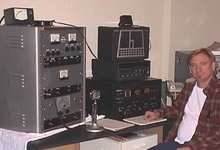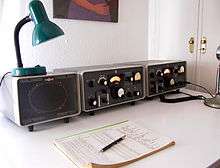Vintage amateur radio

Vintage amateur radio is a subset of amateur radio activity, considered a form of nostalgia or hobby much like antique car collecting, where enthusiasts collect, restore, preserve, build, and operate amateur radio equipment from bygone years, most notably those using vacuum tube technology.[1]
Popular modes of operation include voice communication using amplitude modulation (AM), and Morse code using continuous wave (CW) radiotelegraphy. Among enthusiasts, there is considerable interest in owning, restoring and operating vintage military and commercial radio equipment, much of it more than 40 years old. Some undertake to construct their own gear, known in ham slang as homebrewing, using vintage parts and designs. A number of amateur radio clubs and organizations sponsor contests, events, and swap meets that cater to this specialized aspect of the hobby.
Appeal
Many amateurs prefer the relatively precise digital frequency displays and stability of modern, state-of-the-art, microprocessor based amateur radios. Vintage radio enthusiasts contend that modern amateur equipment lacks the aesthetic appeal and "soul" of amateur electronic gear from the vacuum tube era.[2] Additionally, many find satisfaction in taking commercially-made amateur equipment from the 1930s-1970s (affectionately called boat anchors by US amateurs[3][4] because of their large size and weight) and carefully restoring it.[1]

Enthusiasts feel that the spacious electrical and mechanical designs of boat anchor radios are more easily worked on than the miniaturized layouts of modern Japanese gear. Fixing a modern transceiver often involves nothing more than a VLSI chip replacement. Vintage amateur radio devotees enjoy the more primitive experience that boat anchor radios offer, calling it "real radio". Enthusiasts claim that boat anchors sound better than modern equipment, saying that the tube audio from vintage gear is "warmer" and more aesthetically pleasing.[3] Some hobbyists see vintage radio operation as a valuable asset to help preserve the history and heritage of radio for future generations, and may assist in the restoration and operation of vintage radio equipment for historical exhibits, museums and museum ships.
AM activity

Amplitude modulation (AM) was once the main voice mode in amateur radio before being superseded by Single-sideband modulation (SSB). But AM has recently become a nostalgic specialty interest on the shortwave ham bands. Vintage radio operation has drawn a wide range of amateur radio enthusiasts from rock star Joe Walsh, WB6ACU, to former Federal Communications Commission attorney Riley Hollingsworth, K4ZDH.[5] A majority of "AM'ers" stations consist of vintage transmitters and receivers housed in separate cabinets. Some operators have even obtained old AM broadcast transmitters from radio stations that have upgraded their equipment. Others build their equipment from scratch (called homebrewing) using both modern and vintage-era components.[6]
In the United States, amateur radio AM activity can be found on mediumwave, MF and shortwave, HF frequencies (in MHz) which include 1.885, 1.930, 1.985, 3.870-3.885, 7.290-7.295, 7.160, 14.286, 14.330, 21.425, and 29.000-29.200, and sometimes feature "special event" stations using unique call signs. In the United Kingdom, AM activity can be found almost every day on frequencies between 3.615 and 3.625 MHz. The French AM activity can be found almost every day the morning between 6h30 and 8h00 the frequency 3.550 MHz. In Australia, AM activity can be found most days on "7.125" MHz.[7] In New Zealand, AM nets are conducted on Friday evenings on 3.850 MHz at 8:00 pm or 8.30 pm, and on Sunday and Wednesday afternoons on 7.125 MHz at 4:00 pm.[8] Conversations (QSO's in ham slang) are typically configured as "roundtables" consisting of several participants. Interested newcomers are usually encouraged to switch their modern transceivers to AM mode, introduce themselves, and join the conversation.[9]
Classic gear


Vintage operating activity is not limited to the AM mode. Many devotees use their "classic" amateur gear from vintage-era American manufacturers like Eico, EF Johnson, National, Heathkit, Hammarlund, Drake, Collins, WRL, Swan, Signal/One, Lafayette and Hallicrafters, to make radiotelegraphy (CW), SSB, FM and RTTY two-way contacts. Although 1930s through 1970s gear is considered "vintage", collectors may differ on the cutoff dates.[10]
Some even sub-specialize in military radio collecting and undertake to restore and operate surplus communications equipment, much of it dating back to World War II, from the ubiquitous AN/ARC-5 command sets and US Signal Corps SCR-300 and SCR-536 walkie talkies to exotic gear like the British Paraset, a small espionage transceiver supplied to Resistance forces in France, Belgium and the Netherlands.[10]

There is considerable interest in vintage military and commercial radio equipment among EU amateur radio operators, especially gear from British manufacturers such as Marconi, Racal, Eddystone, Pye, and a variety of Russian, German, Canadian, British RAF and British Army equipment, such as the well known Wireless Set No. 19.
Glowbugs

"Glowbugs" are a related aspect of vintage radio and harken back to the early days of amateur radio, when the majority of hams hand-crafted their own equipment. Smaller in size than "boat anchors", "glowbug" is a term used by US amateurs to describe a simple home-made tube-type radio set, reminiscent of the shortwave radio-building craze of the 1920s and 1930s. "Glow" refers to the glow of the vacuum tubes and "bug" to the gear's relatively diminutive size. The Doerle regenerative receiver and Hartley transmitter circuits are considered "classic" glowbug designs. Generally, any small, home-built tube-type transmitter or receiver may be referred to as a glowbug. The majority of glowbug transmitters are designed to be used in the CW radiotelegraphy mode.
As late as the 1960s, glowbugs were part of many beginner ham stations, and the ARRL Radio Amateur Handbook for those years exhibited a number of such simple, tube-based designs. Today, glowbug operators are enjoying a resurgence of interest among QRP enthusiasts and others with a penchant for constructing their own equipment. Many hams are assembling "glowbug rigs" on improvised chassis such as tin cakepans and wooden boards, and putting them on the air between 7040 – 7050 kHz and 7114 – 7125 kHz. Amateur radio Glowbug enthusiasts can often be heard communicating on the shortwave bands via CW using Morse code. Popular frequencies to hear glowbug contacts are around 3560 kHz and also 3579.5 kHz, chosen because crystals for this frequency can be salvaged from discarded color TV sets, along with other transmitter components.[11][12]
Clubs, events, and publications

Many vintage radio clubs sponsor special events and contests, such as the "AM QSO Party" sponsored by the Antique Wireless Association, the "Heavy Metal Rally" sponsored by Electric Radio Magazine, and the "Classic Radio Exchange".[13] Such operating events are not traditional ham radio contests inasmuch as they are a night of friendly QSO’s using home-built, restored commercial ham, broadcast or military equipment.
The Amateur Radio Lighthouse Society and The AM Radio Network's[14] "Expedition to Thomas Point Shoal Lighthouse" in Chesapeake Bay, MD commemorated the history of lighthouses with a vintage special event station using the call sign K3L.[15]
Britain's Vintage and Military Amateur Radio Society (affiliated with the Radio Society of Great Britain) coordinates regular on-air "nets" where enthusiasts gather as well as massive technical files for the benefit of members.[16] The Surplus Radio Society, a Dutch society of collectors of old ex-military radio equipment and other nostalgic receivers and transmitters holds weekly radio activity nets every Sunday on 3.575 MHz CW / 3.705 MHz AM and sponsors several flea markets and exchange fairs each year.[17]
The Canada-based The Wireless Set No. 19 Group,[18] with members virtually world-wide, caters to those who collect, restore and/or operate vintage military communications equipment, with emphasis on the World War II Wireless Set No. 19 radio. Many members are Amateur Radio operators who use the equipment for on-air contacts with others.
The ARRL publishes "Vintage Radio", a collection of articles from QST magazine describing vintage equipment and restoration, and CQ Amateur Radio magazine releases a yearly "Classic Radio Calendar" featuring full-color vintage radio images.
Safety

Those accustomed to making repairs on solid state equipment are cautioned that vacuum tube gear contain potentially lethal voltages. The practice of discharging power-supply capacitors and keeping one hand in your pocket when working on powered-up gear are essential safety measures. Some older equipment directly connects the metal chassis to one side of the incoming AC line, a practice which results in the entire unit becoming electrified if the wall plug is inserted backwards. Many older radios, such as vintage receivers, are not safety-fused. Restorers generally replace the AC line cord with a more modern 3 wire plug and install an in-line or chassis mount fuseholder. The use of a common station ground connection to all equipment is encouraged.[3] Those who collect, restore or otherwise use vintage radio equipment should also be aware of possible radioactive substances.[19][20]
See also
References
- 1 2 Haring, Kristen (2007). Ham radio's technical culture. MIT Press. ISBN 978-0-262-08355-3. Retrieved June 19, 2010.
- ↑ "Why Boatanchors? by John Brewer WB5OAU". Virhistory.com. 2010-10-05. Retrieved 2011-03-12.
- 1 2 3 Boatanchors FAQ
- ↑ "Origins Of Hamspeak". Ac6v.com. Retrieved 2011-03-12.
- ↑ "Hollingsworth Era" of Amateur Enforcement Enters Fourth Year ""I am proud of the Amateur Service." Riley Hollingsworth, K4ZDH, at home in his well-equipped basement ham shack. Hollingsworth's gear includes several "vintage" operating positions." Source: The ARRL Letter Vol. 20, No. 49 December 14, 2001
- ↑ "Radio World Online". Radioworld.com. 2001-06-20. Retrieved 2011-03-12.
- ↑ AM activity frequency 3.550 MHz
- ↑ "Society For The Preservation Of Amplitude Modulation". New Zealand Association of Radio Transmitters. 11 April 2016. Retrieved 24 September 2016.
- ↑ ARRL QST article: Classic Rigs And Amplitude Modulation
- 1 2 Richard H. Arland (16 August 2007). ARRL's Low Power Communication: The Art and Science of Qrp. American Radio Relay League. pp. 11–. ISBN 978-0-87259-104-2.
- ↑ "''TV Set Salvage'' by ThomasArey". Make-digital.com. 2007-01-31. Retrieved 2011-03-12.
- ↑ "Glowbugs resources". Webhome.idirect.com. Retrieved 2011-03-12.
- ↑ "Classic Exchange". Qsl.asti.com. 2010-01-03. Retrieved 2011-03-12.
- ↑ "AM Radio Network". Amfone.net. Retrieved 2011-03-12.
- ↑ "K3L information". Amfone.net. Retrieved 2011-03-12.
- ↑ Vintage Military Radio Society
- ↑ "Surplus Radio Society". Xs4all.nl. Retrieved 2011-03-12.
- ↑ Bob Cooke VE3BDB. "The ORIGINAL Wireless Set No. 19 Group". Qsl.net. Retrieved 2011-03-12.
- ↑ Bob Cooke, VE3BDB. "Danger! Hazardous Material on Your Vintage Rig". Qsl.net. Retrieved 2011-03-12.
- ↑ George Hamner, KW7GAM. "Radio-activity". Retrieved 2011-03-22.
External links
- AM North America
- ARRL amplitude modulation page
- Antique Wireless Association
- Glowbug resources
- Electric Radio Magazine
- Vintage And Military Amateur Radio Society (UK)
- Ham radio equipment Reference Guide
- Nostalgic Kits Central Pictures, schematics, service bulletins, modifications, specifications and more of a large number of vintage electronics sold as kits
- Old Time Radio Shacks photos from “OSL Cards from the Past” www.oldqslcards.com